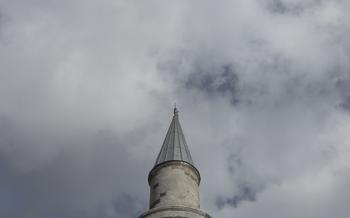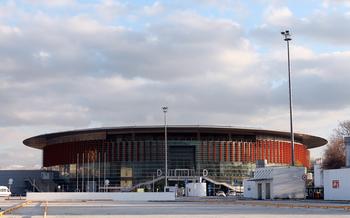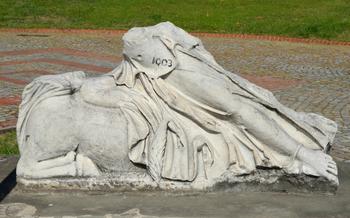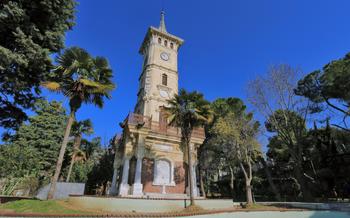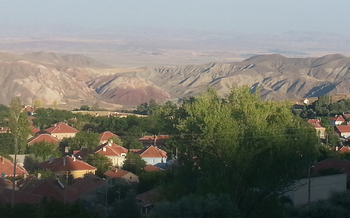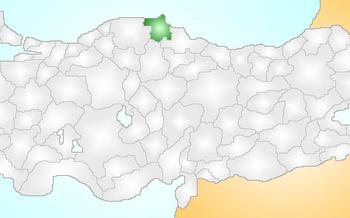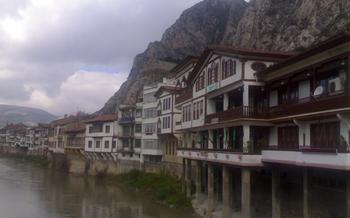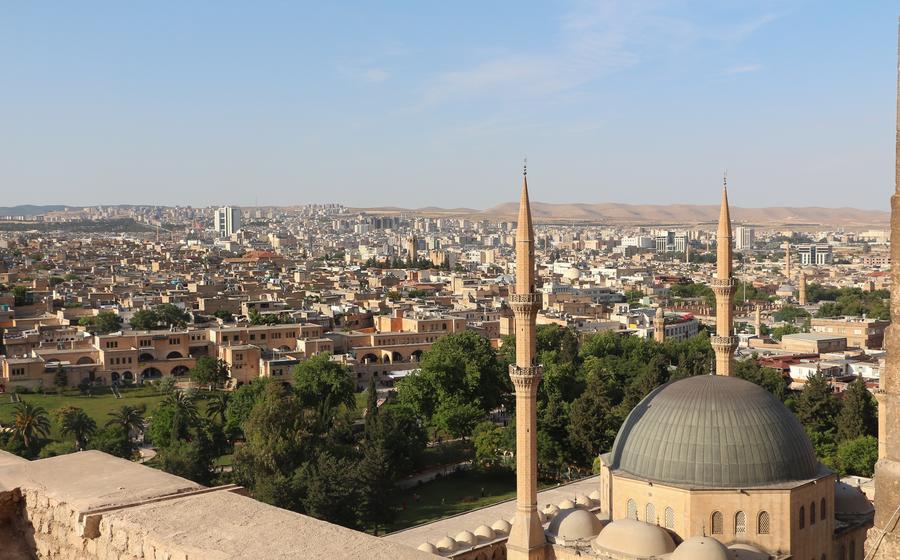
Aleppo Button Museum (Bakırcılar Çarşısı)
- Delve into the History of the Aleppo Button Museum:
- Discover the Enchanting Bakırcılar Çarşısı
- Explore the Museum's Diverse Collection
- Learn about the Craftsmanship of Button-Making
- Admire the Intricate Designs and Patterns
- Understand the Cultural Significance of Buttons
- Appreciate the Button-Making Process:
- Discover the Stories Behind the Buttons:
- Experience Interactive Displays and Workshops
- Explore the Surrounding Area
- Plan Your Visit
- Capture the Beauty of the Buttons:
- Support Local Artisans:
- Engage with the Museum's Community:
- Insider Tip:
Delve into the History of the Aleppo Button Museum:
Nestled in the heart of Şanlıurfa, the Aleppo Button Museum stands as a testament to the city's rich cultural heritage and its deep connection to the art of button-making. The museum's origins can be traced back to the thriving button-making industry that flourished in the Aleppo region during the Ottoman Empire. As skilled artisans migrated from Aleppo to Şanlıurfa, they brought with them their expertise and passion for crafting intricate and beautiful buttons. The museum was established in 2013 to showcase this unique cultural heritage and preserve the traditional techniques of button-making.
The Aleppo Button Museum houses a diverse and fascinating collection of buttons, each telling a unique story about the cultural significance of these small yet essential objects. From intricate mother-of-pearl designs to simple wooden buttons, the collection reflects the diverse materials and techniques used by button-makers throughout history. The museum's mission is to protect and promote this cultural heritage, ensuring that the legacy of Aleppo's button-making tradition continues to inspire future generations.
Discover the Enchanting Bakırcılar Çarşısı
The Aleppo Button Museum is nestled within the vibrant Bakırcılar Çarşısı, a bustling market that has been the heart of Şanlıurfa's trade and commerce for centuries. The market is a vibrant tapestry of sights, sounds, and smells, where merchants hawk their wares, artisans showcase their skills, and shoppers haggle for the best prices.
Bakırcılar Çarşısı has a rich history dating back to the Ottoman era, when it was a major center for copper and brassware production. Today, the market is still renowned for its copper and brass workshops, but it also offers a diverse range of other goods, including textiles, spices, jewelry, and souvenirs.
As you stroll through the narrow cobblestone streets of the market, you'll be captivated by the colorful displays of merchandise and the lively atmosphere. The air is filled with the sounds of haggling merchants, the clinking of copper pots and pans, and the laughter of shoppers.
In addition to the Aleppo Button Museum, Bakırcılar Çarşısı is home to a variety of other attractions and shops. You can visit traditional crafts workshops, where artisans create intricate copper and brassware using ancient techniques. You can also find souvenir shops selling a wide range of items, from traditional Turkish handicrafts to modern souvenirs.
The lively ambiance of Bakırcılar Çarşısı perfectly complements the museum experience. After exploring the fascinating world of buttons, you can step outside and immerse yourself in the vibrant atmosphere of the market. It's the perfect place to soak up the local culture, interact with the friendly locals, and find unique souvenirs to take home.
Explore the Museum's Diverse Collection
The museum's vast and diverse collection boasts an array of buttons crafted from various materials, including precious metals, gemstones, wood, and natural fibers. Each button is a testament to the intricate craftsmanship and artistic flair of the button-makers. From delicate mother-of-pearl designs to simple yet elegant wooden buttons, the collection showcases a wide spectrum of styles and techniques.
Intricate carvings, delicate filigree work, and colorful enamel adorn many of the buttons, transforming them into miniature works of art. Some buttons feature intricate geometric patterns, while others showcase intricate floral motifs or even depictions of animals and mythical creatures. Visitors can marvel at the sheer variety and beauty of these buttons, each one telling a unique story about the culture and heritage of the region.
Among the highlights of the collection are a set of gold buttons adorned with precious gemstones, a rare example of the opulence and extravagance of button-making in the past. Another remarkable piece is a wooden button carved with a scene from a traditional Turkish folktale, demonstrating the rich storytelling tradition associated with buttons.
The museum's collection is not merely a display of beautiful objects but also a valuable repository of cultural heritage. Each button represents a piece of the region's history, its traditions, and its artistic achievements. Visitors to the Aleppo Button Museum can immerse themselves in this rich cultural tapestry and gain a deeper appreciation for the art and craftsmanship of button-making.
Learn about the Craftsmanship of Button-Making
The Aleppo Button Museum showcases the intricate craftsmanship and traditional techniques used to create Aleppo buttons. Visitors can learn about the various steps involved in the button-making process, from sourcing the raw materials to finishing the final product. Skilled artisans use hand-carving, engraving, and inlay work to create these exquisite works of art.
The museum houses a collection of tools and equipment used by button-makers, providing visitors with an insight into the skills and expertise required to produce these intricate pieces. Visitors can also watch live demonstrations by experienced artisans, gaining a deeper appreciation for the craftsmanship and dedication that goes into each button.
Admire the Intricate Designs and Patterns
The Aleppo Button Museum houses a mesmerizing collection of buttons that showcases a diverse range of designs and patterns. From intricate mother-of-pearl inlays to delicate filigree work, each button is a testament to the skill and artistry of the button-makers. The designs are inspired by various cultural influences, including Islamic art, traditional Turkish motifs, and European styles. Visitors can find buttons adorned with geometric patterns, floral designs, animal figures, and even calligraphy. The symbolism and cultural significance of these designs add depth and meaning to the buttons, making them more than just functional objects. The intricate patterns and designs are not merely decorative; they are a reflection of the rich cultural heritage of the region and the creativity of the artisans who crafted them.
Understand the Cultural Significance of Buttons
Buttons have played a vital role in Turkish culture, transcending their functional purpose to become symbols of social status, wealth, and personal style. In traditional Turkish society, the type of buttons used on clothing often indicated a person's social standing. Elaborate and ornate buttons were reserved for the wealthy and influential, while simpler buttons were worn by the common people. Buttons were also used to convey personal style and preferences. The choice of color, design, and material reflected an individual's taste and personality.
Beyond their decorative function, buttons also held cultural significance in local customs and traditions. For example, in some regions of Turkey, buttons were used as talismans to ward off evil spirits or bring good luck. In traditional Turkish weddings, the bride and groom would exchange buttons as a symbol of their love and commitment. These cultural associations added depth and meaning to the humble button, transforming it into a symbol of identity and heritage.
Appreciate the Button-Making Process:
The button-making process is a fascinating blend of art and craftsmanship. Visitors to the Aleppo Button Museum can gain a deeper understanding of this intricate process through a step-by-step overview. From sourcing the raw materials, such as precious metals, gemstones, or natural fibers, to the final finishing touches, each stage requires skill and attention to detail. The museum showcases the tools and equipment used by button-makers, including traditional hand tools and modern machinery. Visitors can learn about the challenges involved in creating high-quality buttons, such as achieving symmetry, intricate carvings, or delicate inlay work. The museum also shares interesting facts and stories related to the button-making process, providing a unique glimpse into the lives and work of these skilled artisans.
Discover the Stories Behind the Buttons:
Delving into the Aleppo Button Museum's collection is not just about admiring the intricate designs and craftsmanship of the buttons; it's also about uncovering the captivating stories and histories that lie behind each one. These buttons, once mere fasteners, become vessels of personal narratives, connecting visitors to the rich cultural heritage of the region.
One button may have adorned the garment of a nomadic tribesman, embarking on epic journeys across the vast Anatolian plains. Another might have graced the robes of a revered Sufi mystic, absorbing the spiritual energy of countless prayers and meditations. Some buttons may have witnessed the joyous celebrations of weddings or the somber rituals of funerals, carrying within them the emotions and memories of those significant life events.
The museum staff is a treasure trove of knowledge when it comes to these stories. They can share anecdotes about the button-makers who meticulously crafted each piece, the families who cherished them for generations, and the adventures they embarked on along the way. These stories add depth and meaning to the museum experience, transforming the buttons from mere objects into tangible links to the past.
The museum is also actively involved in research projects aimed at uncovering the stories behind the buttons. Through collaboration with historians, anthropologists, and local communities, they strive to piece together the rich tapestry of lives that these small, unassuming objects have touched. Visitors may have the opportunity to contribute to this ongoing research, adding their own insights and helping to preserve the cultural heritage of the region.
Experience Interactive Displays and Workshops
The Aleppo Button Museum offers a range of interactive displays and workshops that enhance the visitor experience and provide a deeper understanding of the button-making process. Visitors can watch skilled artisans demonstrate the traditional techniques used to create Aleppo buttons, from hand-carving to inlay work. Interactive displays allow visitors to explore the different materials used in button-making, such as precious metals, gemstones, and natural fibers.
One of the highlights of the museum is the hands-on button-making workshop, where visitors can try their hand at creating their own unique buttons. Under the guidance of experienced instructors, participants can learn the basics of button-making, from selecting the right materials to finishing the final product. The workshop provides a fun and interactive way to engage with the museum's collection and gain a deeper appreciation for the skill and artistry involved in button-making.
Explore the Surrounding Area
After immersing yourself in the world of buttons at the Aleppo Button Museum, take some time to explore the surrounding area and discover the other cultural treasures of Şanlıurfa. Start your journey at Göbeklitepe, a mysterious and awe-inspiring archaeological site located just 15 kilometers from the city. This UNESCO World Heritage Site is believed to be the oldest temple in the world, dating back to 10,000 BC. Marvel at its massive stone pillars and intricate carvings that offer a glimpse into the lives and beliefs of our ancient ancestors.
Next, head to the Şanlıurfa Museum, which houses a rich collection of artifacts that tell the story of the city's long and storied past. From prehistoric tools to Roman mosaics and Islamic manuscripts, the museum offers a fascinating journey through the ages. Don't miss the chance to see the famous Şanlıurfa Man, a 9,000-year-old human skull that is one of the oldest examples of human remains in the world.
For a taste of local culture and tradition, visit the Şanlıurfa Bazaar, a vibrant and colorful marketplace where you can find everything from spices and textiles to traditional Turkish handicrafts. Immerse yourself in the sights, sounds, and smells of this bustling bazaar, and be sure to sample some of the delicious local cuisine, such as urfa kebabı or lahmacun.
Finally, no visit to Şanlıurfa is complete without experiencing the Halfeti Village, a picturesque town located on the banks of the Euphrates River. Take a boat tour to explore the village's unique architecture, including its iconic black-and-white striped houses, and marvel at the stunning views of the surrounding countryside.
Plan Your Visit
Before embarking on your journey to the Aleppo Button Museum, it's essential to plan your visit to make the most of your experience. The museum's doors are open from [Opening hours], welcoming visitors to delve into the world of buttons. To enhance your visit, consider the following recommendations:
Best Time to Visit:
Şanlıurfa's pleasant weather makes it an ideal destination year-round. However, the spring (April-May) and autumn (September-October) offer the most comfortable temperatures for exploring the city and its attractions, including the Aleppo Button Museum. During these seasons, you can stroll through the streets without the scorching summer heat or the winter chill.
Getting to the Museum:
The Aleppo Button Museum is conveniently located in the heart of Şanlıurfa, within the vibrant Bakırcılar Çarşısı. To reach the museum, you can either take a leisurely walk from your hotel or utilize the city's efficient public transportation system. Taxis are also readily available if you prefer a direct and comfortable ride.
Guided Tours:
To gain deeper insights into the history and significance of the buttons, consider booking a guided tour of the museum. Knowledgeable guides will lead you through the exhibits, sharing fascinating stories and anecdotes about the collection. Guided tours are available in various languages, ensuring that visitors from all corners of the globe can appreciate the museum's treasures.
Photography Guidelines:
To preserve the integrity of the buttons and the museum's ambiance, flash photography is not permitted within the exhibition halls. However, you are welcome to capture the beauty of the buttons through photographs without flash. Share your stunning shots on social media using the hashtag [#hashtag] to connect with fellow button enthusiasts and showcase the museum's allure to the world.
Capture the Beauty of the Buttons:
Document your visit to the Aleppo Button Museum by capturing the intricate beauty of the buttons through photography. Share your photos on social media using the hashtag #AleppoButtonMuseum to connect with other visitors and showcase the diversity of the collection. Experiment with different angles, lighting, and compositions to create visually striking images that highlight the unique designs and craftsmanship of the buttons. Consider creating flat lay arrangements or using macro photography to showcase the intricate details up close. Participate in photo contests or exhibitions organized by the museum to share your creativity and contribute to the promotion of this unique cultural heritage.
Support Local Artisans:
Supporting local artisans and preserving traditional crafts like button-making are crucial to maintaining the cultural heritage of Şanlıurfa. Visitors can contribute to this effort by purchasing buttons or other handmade souvenirs from the museum shop. These purchases directly support the artisans, allowing them to continue their craft and pass on their skills to future generations. The museum also collaborates with local artisans to organize workshops and exhibitions, providing a platform for them to showcase their work and connect with visitors. By engaging with the artisans, learning about their craft, and sharing their stories, visitors can play a vital role in promoting and preserving the rich cultural traditions of the region.
Engage with the Museum's Community:
The Aleppo Button Museum has a vibrant online community of button enthusiasts, historians, and culture lovers. Visitors are encouraged to connect with the museum on social media platforms like Instagram, Facebook, and Twitter to share their experiences, ask questions, and participate in discussions related to buttons and the museum's collection. The museum's staff and volunteers are passionate about preserving cultural heritage and are always happy to engage with visitors and share their knowledge. Visitors can also sign up for the museum's newsletter to stay updated on upcoming events, workshops, and exhibitions, both virtual and in-person. By becoming part of the museum's community, visitors can deepen their understanding of the art of button-making and its cultural significance, and connect with like-minded individuals who share their passion for preserving traditional crafts. The museum's online presence provides an opportunity for visitors to extend their museum experience beyond their visit and stay engaged with the museum's mission and community.
Insider Tip:
For a truly immersive experience, visit the Aleppo Button Museum during one of its live button-making demonstrations. These demonstrations showcase the intricate craftsmanship and techniques involved in creating these unique works of art. Watch as skilled artisans transform raw materials into beautiful buttons, using traditional tools and methods passed down through generations. You'll gain a deeper appreciation for the artistry and skill that goes into each button, and leave with a newfound respect for the rich cultural heritage of Şanlıurfa.
